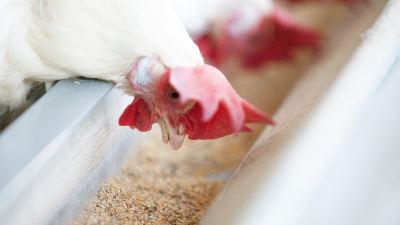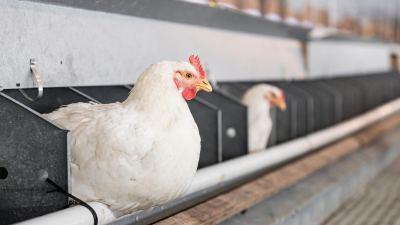Dr. Karl Dawson: Practical purposes: Redefining feeding strategies with nutrigenomics

Below is a transcript of Tom Martin’s interview with Dr. Karl Dawson, vice president and chief scientific officer at Alltech and co-director of the Alltech Center for Animal Nutrigenomics and Applied Animal Nutrition.
Click below to hear the full interview:
Over the last 10 years, scientists at Alltech have been using nutrigenomics to define a variety of new nutritional concepts, manage product development and redefine our view of nutrition. What are the practical applications of the science, and what does it mean for the future of feeding and farming? Tom Martin talked with Dr. Karl Dawson, vice president and chief scientific officer at Alltech.
Tom: Let’s begin with the question: What is nutrigenomics?
Karl: Nutrigenomics is a system for looking to see how the environment, disease processes and nutrition influence gene expression in an animal. This is taking the basic information that comes in an animal’s genetic makeup, its DNA, and looking to see how that's used. This system allows us to look at numerous genes at a time. And in some of our studies, we would be looking at as many as 25,000 genes at a time. So, we get very precise in our measures of what the environment, or disease — or, in this case, nutrition — does to that animal.
Tom: In a recent panel discussion, the webinar “Farming the Future,” you said that nutrigenomics is really going to redefine things, if it hasn't already. Can you elaborate on that?
Karl: Yes. We’re going to be looking at nutritional processes in a totally different way. We could also look at things like diseases in a different way. The way we look at nutrition today is based on a narrow group of responses in an animal to a nutritional strategy. Nutrigenomics allows us to do that same kind of thing while looking at many, many different characteristics at once and very rapidly. We can look at changes induced by nutrition within several days instead of waiting for a whole production cycle, which may take anywhere from 42 days to two years.
Tom: The name of the field, nutrigenomics, might lead us to believe that it’s limited to exploring how nutrition influences the expression of individual genes, but is it more than that? Does the science also look at disease and environmental factors and how they’re related to nutrition?
Karl: Yes. We can look at all of those things and how they're related. “Nutrigenomics” may be a misnomer. In the science world, we call it “transcriptomics,” the idea of looking at these genes and how they're transcribed. But the word “nutrigenomics” has taken off, and it’s really being used to describe just about anything to do with gene expression and factors that influence gene expression.
Tom: How is this tool being used to define new feeding strategies?
Karl: We can talk about a couple of examples that have developed over the last seven or eight years. One of those is the feeding of young animals. We could take a chick during the first 96 hours after hatching and change its nutrition — by limiting its nutrients, we can change how that animal performs throughout its life or its nutrient requirements throughout its life. We would not have been able to know what that looked like until we had this nutrigenomics tool.
We can show that the gene expression pattern changes in a young bird when you've limited its nutrients, but those changes that take place in that gene are reflected throughout the life of that bird. So, some 24 days later, that bird has a totally different environment that it is working with, and the types of nutrients it requires have changed. It's a totally different animal when it comes to its nutritional requirements.
Tom: And does this bring more consistency, more precision to farming?
Karl: Yes. It’s going to bring a lot of precision, but it actually gives you a new tool because, in some of those changes we’re seeing, we can decrease the amount of nutrients that animal is requiring. You condition it to a low nutrient value or nutrien. As it grows, it’s expecting that as it goes on through its life. So, for example, its mineral requirement may be decreased by as much as 50 percent. That’s a totally different world for that animal to grow in, and it changes the way we feed that animal to optimize its performance and health.
Tom: Let's say there's been a blood draw or a tissue sample taken from the herd or the flock on the farm and brought to the lab to process. How long does it take to get that information back to the farm?
Karl: It only takes about 48 hours for us to process a sample, but I don't want to mislead you here. We would not necessarily use this as a diagnostic tool at this point. Today, it's a research tool to show you what changes happen with a new trend. We can use it to screen new nutritional strategies or look at nutrients in the way they're influencing that animal. Eventually, you’re going to see some diagnostic tools coming from that. But today, that probably isn't a very realistic approach for this type of technology.
Tom: What are some new commercially useful feeding concepts that have come directly from the use of this molecular tool?
Karl: A couple come to mind immediately. One of them has been a rather surprising observation. Often, in the growth of that young animal and growing livestock, we’ll use enzyme supplements. The idea behind using an enzyme supplement is really to change what is happening to the food, how it's digested. Well, one of the surprising things that we found using nutrigenomics is, that is reflected not only in the digestion process, but actually the way the tissue develops in that animal. It changes the receptors for hormones. It changes the way that animal responds physiologically.
That technology has moved forward and is the basis of a couple of different programs that we’re using in beef cattle today — to use enzymes to enhance their growth and performance. In some systems, we found that this can be worth as much as $15 to $20 per head when that animal reaches its final stages of growth or finishes out and goes on for beef production. So, it's a pretty substantial thing. We never would have seen that, or even thought about doing that, if it hadn't been for that nutrigenomic tool that allows us to see those changes in those animals.
Tom: I also recall from the webinar, “Farming the Future,” some discussion about the influence of minerals.
Karl: Absolutely. Minerals are very important, and that's one of the areas that probably was the hallmark of our nutrigenomics work when we started out. One mineral, specifically, is selenium. Selenium is a nutrient that's very important, but we had no idea of how much or what the ramifications of feeding selenium really were. We found all sorts of hidden traits that are influenced by selenium, all the way from reproduction to the development of brain tissue and the speed at which an animal grows.
One of the most interesting traits is the way that animal generates energy. We found very early on that we could change the function of the mitochondria and the cell. This is the energy-producing organ within that cell. We can increase its efficiency by about 15 to 20 percent. That doesn't sound like a big number, but using a dairy cow for example, that means we can improve its energy efficiency by that same amount, which probably means 2 to 3 liters of milk a day from a cow.
So, this is turning everything upside down. We've changed what we thought we knew about energy metabolism, and it's a totally different world now. We're going to have to go back now and redefine energy metabolism — not based on the energy content of the feed, but based on these minerals and the way they are interacting with that energy source.
Tom: Let's say there's a new feed supplement out there on the market and you want to determine its value as quickly as you possibly can. Can nutrigenomics do that?
Karl: Absolutely. That’s one of the most exciting examples I have right now. Several years ago, we were asked to come up with an alternative antioxidant to help us address the shortage of vitamin E. We took a nutrigenomics approach to that issue and developed what we thought was a new material to serve as a booster for vitamin E activity. Normally, to evaluate a new antioxidant system like that, we would have done it over a period of several years. It takes time to grow the animals, look to see what the vitamin E is doing, to harvest the meat product and evaluate the way that is responding to oxidative stress.
With a nutrigenomics approach, we were able to do the same types of evaluation, but we can look at gene expression as our measure. In doing so, we could shorten that two-year period to about six weeks. We could actually evaluate what that new ingredient was doing during that very short time.
Tom: By applying this tool, you're gaining a lot of information, a lot of knowledge. How does that information influence the way you think about nutrient requirements?
Karl: We’ve changed a lot in terms of nutrient requirements. We talked about selenium a minute ago. We used to have a fairly standard idea of what selenium requirements were. Using nutrigenomics, we’ve been able to redefine that, and found that by changing the form of selenium — by putting it in the form of a selenium yeast, for example — we could decrease its requirements by about 50 percent.
We’ve gone on to look at all sorts of different minerals. We know that we can cut back on a lot of the requirements we expect for copper and zinc in the diet. We can cut those by as much as 75 percent. So, we have really started to change that. Instead of asking what a mineral is doing, we look at the form of that mineral as well as how much we're providing it. Again, it’s turning things upside down. The old requirements we had for some of these minerals have really changed.
Tom: How is nutrigenomics being used to demonstrate the effects of maternal nutrition on the growth or development and the disease resistance of offspring?
Karl: This has been another very exciting area. We did some studies several years ago in pigs — looking to see what would happen to the offspring if we fed a particular carbohydrate or supplement to the sow. We fed the sows a particular carbohydrate called Actigen®, which is a yeast product. Then, we looked to see what was happening in the piglets. To our surprise, by looking at the gene expression in those piglets, we could easily differentiate the piglets that came from the sow that was fed that material. In fact, we found some very specific genes were being changed. One of the more interesting effects was to the hormones that influenced the ability of that young pig to eat.
We could stimulate intake in those young pigs, not by feeding the young pigs the material, but by feeding the sow. That changes what we think in terms of overall production, because now we have a different animal to work with. They have different gene expression patterns and, in fact, different nutrient requirements. Their resistance to specific diseases has changed.
Tom: Does this enhance that consistency that we were talking about earlier across generations?
Karl: Yes. That's the idea. We've always thought that consistency occurs, and we have evidence of it in the human population — that you are what your mother eats. Nutrigenomics actually gives us the tools to see what is changing specifically, and to program that into the production process.
Tom: We've been talking about animals here as though they were something separate and apart from us, but we're animals as well. Does nutrigenomics influence the way that we think about human nutrition?
Karl: Absolutely. We’ve really projected into the human population from what we've done in animals with nutrigenomics. One of the star programs that we have right now is a set of compounds that we've developed to provide a preventative for Alzheimer's disease. This program came directly from our observations of what was happening to gene expression. We realized that the genes that were being expressed — or not being expressed — in Alzheimer’s patients were, in fact, associated with Alzheimer’s and the development of neurological tissue. We were able to track that relationship down, and it’s in clinical studies today.
We've done similar things with some of the yeast products that we’re using. We know that they influence animals. We are now doing the same types of nutrigenomic studies in humans to evaluate how these might be useful to address health issues.
Tom: I know from past conversations with you about the science of nutrigenomics that you feel that it holds a lot of promise. What is your take home message about this science?
Karl: That this is an extremely powerful tool. It probably gives us more information and more precision for feeding animals — and probably even humans — in the future. It’s going to be a very powerful tool for changing the way we develop our feeding strategies. So, my take home message is, “This thing is going to be something that will influence the way science changes our nutrition.”















